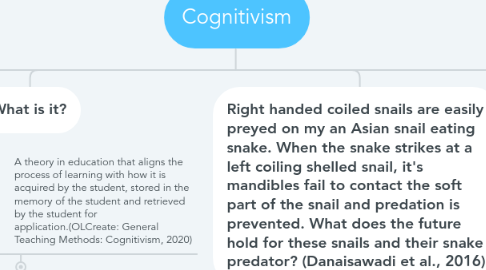
1. Why use it?
1.1. Information is chunked and streamlined to reduce the cognitive load of a learner (Brieger, et al., 2020)
1.1.1. A cognitive load refers to how much can be committed to working memory at a time. For example, reading a children's book has a smaller cognitive load than a peer reviewed academic journal on differentiation.
1.2. If the teacher provides the scaffolding for support, a learner can bridge and combine knowledge for an overall grasp of a concept.
1.3. Repipition is an effective way to learn by practicing and recalling the information
1.4. The use of concept maps (like this one!) allows a cognitive learner to organize information for storage and recall (Forrest, 2016).
2. What is it?
2.1. A theory in education that aligns the process of learning with how it is acquired by the student, stored in the memory of the student and retrieved by the student for application.(OLCreate: General Teaching Methods: Cognitivism, 2020)
2.1.1. This means information needs to be organized in a systematic way for delivery to the learner and the teacher must provide support for recalling the information.
3. Right handed coiled snails are easily preyed on my an Asian snail eating snake. When the snake strikes at a left coiling shelled snail, it's mandibles fail to contact the soft part of the snail and predation is prevented. What does the future hold for these snails and their snake predator? (Danaisawadi et al., 2016)
4. How I am going to use it in my unit
4.1. Students will use the Cornell Note-taking System to take lecture notes for direct instruction. Cornell Notes allow the students to summarize and "chunk" the information they just learned by having them write a short summary the next day and also writing the main ideas off to the side of the page so they can access information later (The Cornell Note Taking System – Learning Strategies Center, 2016)
4.2. The unit I am planning is evolution. Students will build a concept map illustrating the evidence for evolution using a web based platform like Mindmeister.
4.3. Scaffolding information so that students can see the relatedness. This is imparitive when teachign evoltuion as it is highly misunderstod. To start, student would be given the actual dfinition of evoltuion : the change in the allele frequency of a population. Then, use the process of natural selection to build upon the concept of evolution using real world examples such as:
4.3.1. African Elephants- Due to constant poaching pressures more calves are born now that are tusk less in adulthood than ever before. Before poaching, tusks made it easier to find water or to fight rivals (males) so elephants without tusks had a low fitness or reproductive success. Poaching has provided a selection pressure as tusk less elephants are more likely not to be killed and therefore can pass their tusk less genes to their offspring, increasing the allele frequency of the population
4.3.2. Humpback whales communicate by singing. The songs travel thru the water long distances to other humpback whales. A humpback whale with a mutation that causes his song to be song at the wrong frequency will not be able to find a mate. his mutation will not be passed to the next generation.
4.3.2.1. This whale is called Blue-52. He exists and scientist want to figure out his mutation. This is very sad as he sings constantly trying to find a whale to respond, but because the ocean is vast and he is using the wrong frequency, he is alone.
